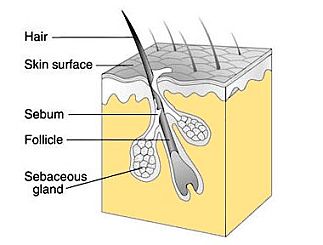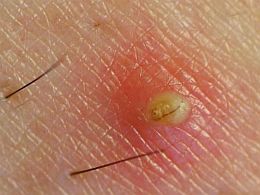Ingrown Hair
What is an Ingrown Hair?
Hair is made of a protein called keratin. It comes through the hair follicles and breaks through the skin. Sometimes hair grows slanted into the skin instead of breaking through horizontally. When this occurs it is considered ingrown hairs. In addition, ingrown hairs can develop when hair curls backwards instead of pushing out through the skin. When the hair is trapped within the skin (ingrown hair) it causes inflammation, itching, pain and irritation at the site.
In some cases, ingrown hairs can lead to severe infections that require medical treatment. These hairs typically occur on the cheeks, chin, beard area (in men) and neck, but they can also arise on the scalp of men who frequently shave their scalp hair. In women, ingrown hairs normally occur in their public area, armpits and/or legs. Ingrown hair can also appear in less common places such as around the eyebrow, chest, back, underarm, and groin area.
It is important to note that although African American males, between the ages of 15 to 25, have the highest risk for ingrown hairs, this condition can occur in anyone.
What is a Hair Follicle?
A hair follicle is the sac from which hair grows. Sensory nerve fibers, at the base of the hair follicle, coil around each hair bulb. When the hair bends it stimulates the nerve endings, which can cause a person to feel as though his/her hair has moved. It is important to note that the main functions of hair are: to protect the scalp, skin and hair follicles from damage, regulate body temperature, aid in perspiration evaporation and act as sensory organs. Sebaceous glands (found in the hair follicles) produce the oil that keeps the scalp and hair conditioned.

Image of a healthy hair
What Causes Ingrown Hairs?
People with naturally curly hair are more likely to develop ingrown hairs than people with naturally straight hair, which is why ingrown hairs tend to arise in the pubic area. Pubic hair is often tightly coiled, even in individuals who have naturally straight scalp hair. Ingrown hairs typically develop in this area when tight clothing rubs the skin causing it to become irritated and inflamed. When this occurs the hairs are prevented from breaking through the skin, which can lead to ingrown hairs.
In addition, people with thick, coarse hair have a higher risk of developing ingrown hairs than people with thin, fine hair. Moreover, ingrown hairs can occur as a result of shaving (in both men and women). Shaving can stretch the skin causing the hair to curve, grow backwards and/or slant. Ingrown hairs, can also occur if the individual uses more than one blade, shaves too closely to the skin and/or shaves against the natural flow of hair growth. Your skin becomes inflamed when it believes the ingrown hair is a foreign invader.
What are the Symptoms of Ingrown Hairs?
Sometimes an ingrown hair can become infected. An infected ingrown hair can be painful and embarrassing. When an ingrown hair becomes infected it can cause the surrounding area to become red, painful, inflamed and itchy. If left untreated an ingrown hair can lead to acne-like marks, permanent scarring and/or chronic skin infections.
The following symptoms are associated with ingrown hairs:
– Pain
An ingrown hair can cause pain, especially if it becomes inflamed and/or infected. The trapped hair can cause whiteheads and swelling in the surrounding area. Pain alerts the body that something is wrong. An infected ingrown hair not only damage the skin, it also cause tenderness and discomfort.
– Inflammation

Ingrown hair with pus
Inflammation is one of the earliest and most common symptoms associated with infected ingrown hairs. It is the body’s way of reacting to the presence of an irritant. It is important to note that inflammation is not the same as an infection rather it is the immune system’s way of protecting the body from a foreign invader like an ingrown hair.
An inflamed ingrown hair can result in pustules. Once the area surrounding the ingrown hair becomes inflamed it can cause a pustule (a pus-filled blister) to form around the hair. Once this occurs the pustule can rupture causing pus and blood to leak from the site. An open wound, like a ruptured pustule, can increase a person’s risk of developing serious infections like Staphylococcus.
– Itchiness
Inflamed and/or infected ingrown hairs can cause itchiness. When dead skin accumulates beneath the skin it can cause the outer layer of the skin to become itchy. Itching is the way the body signals to the individual that dead skin cells and toxins need to be removed. Most people respond to the itch by scratching the area and eliminating the body of those foreign elements.
– Sebaceous Cysts
Sebaceous cysts can develop as a result of ingrown hairs. Women who remove hair by waxing or shaving are susceptible to ingrown hairs. The vulva area is the most frequent place that ingrown hairs arise in women. In some cases these trapped hairs can lead to sebaceous cysts, hard, painless cysts that are caused by blocked hair follicles. Sebaceous cysts normally go away without medical treatment.
– Razor Bumps
Razor bumps, also known as shaving bumps, are a mild form of folliculitis (a hair follicle infection), which is a symptom of infected and/or inflamed ingrown hairs. This condition occurs when the hair begins to grow back, after being shaved, and the body mistakes the growth as a foreign invader. Razor bumps can arise anywhere on the body where hair has been shaved, especially in places where the hair was shaved too close to the skin. Men who frequently shave their facial hair are the most at risk for razor bumps.
What Complications are Associated with Ingrown Hairs?
Ingrown hairs, if left untreated, can lead to serious complications such as:
- One of the main complications associated with ingrown hairs are bacterial infections. This is especially true when the person picks and/or scratches the skin surrounding the trapped hairs.
- Undiagnosed and/or untreated ingrown hairs can lead to temporary or permanent acne-like scarring.
- An infected and/or inflamed ingrown hair can cause pigmentation (coloring of the skin) at the site. It is important to note that some treatments may be responsible for pigmentation.
What Treatments are Available for Ingrown Hairs?
Ingrown hairs typically grow out naturally. The best results are achieved when clothing does not restrict hair growth. In cases in which the ingrown hairs cause inflammation, pain, itchiness, etc. it is best to place a warm washcloth on the infected area several times a day for relief. For chronic inflammation and/or infections, the use of topical antiseptics, antibiotics and/or anti-bacterial cleansers may be used to provide relief and aid in the healing process.
Listed below are some common ingrown hair treatments:
– Topical Treatments
Over-the-counter or prescription topical medications (corticosteroid creams, topical antibiotic creams and/or retinoid creams) can help minor infections. Corticosteroid creams can ease the itchiness and inflammation associated with infected ingrown hairs. Topical antibiotic creams aid in the healing process when they are placed on top of the infected area. Retinoid creams remove dead skin cells and encourage ingrown hairs to break through the skin.
– Lifestyle Changes
Another way to treat hair growing inwards is through lifestyle changes. The first step is to allow the hair to grow out for several weeks before waxing, shaving or tweezing. Next exfoliate the skin on a weekly basis and change razor blades when they become dirty, dull or worn. After that, soak the area for approximately 5-10 minutes – prior to removing the hair (to reduce skin inflammation and irritation).
Avoid wearing clothes (underwear included) that are too tight and/or uncomfortable. Tight clothing can press the hair against the skin or prevent the hair from breaking through the skin properly, therefore increasing the risk of ingrown hairs. Consider permanent hair removal procedures if the infected ingrown hairs continually reoccur.
– Oral Medications
An effective way to treat an inward growing hair is with oral medications. Severe cases of ingrown hairs may require the use of oral antibiotics to prevent new infections or treat existing infections. Oral antibiotics are most often used to treat Staphylococcus, a bacterial infection that can occur when hair follicles become blocked and inflamed. Without proper treatment, these bacteria can spread to surrounding skin causing cellulitis, a more serious bacterial infection.
– Electrolysis
An ingrown hair can be treated with laser treatments such as electrolysis. Electrolysis destroys hair follicles. Once the inward growin hair is successfully removed the hair will not grow back in the treated area. Electrolysis also helps minimize scarring caused by an ingrown hair.
Although it is considered a cosmetic procedure, electrolysis can help lower the risk of ingrown hairs. Electrolysis occurs when a mild electric current flows through the hair follicles from a small, metal probe. The current not only destroys the hair, it also destroys the hair follicle.
How Can Ingrown Hairs Be Prevented?
There are a variety of ways to prevent ingrown hairs. Some of these ways include: not shaving too close to the skin, shaving in the same direction as the hair growth and using gels and/or creams to soften the hair before shaving, waxing and/or tweezing. Softening the skin can prevent the formation of an inward growing hair.
Also, using electrolysis and hair removal creams can decrease the risk of ingrown hairs caused by shaving, waxing and tweezing. It is important to wear loose clothes to prevent rubbing, friction and blocked hairs. Lastly refraining from shaving, waxing and tweezing all together can prevent trapped hairs and therefore lower the risk of ingrown hairs.
References:
American Academy of Dermatology. (2013). Skin of color. Retrieved from http://www.aad.org/media-resources/stats-and-facts/prevention-and-care/skin-of-color#.UdxwM23AHcA
Mayo Clinic. (2013). Ingrown hairs: How do you prevent them? Retrieved from http://www.mayoclinic.com/health/ingrown-hair/DS01167
Medline Plus. (2013). Hair follicle anatomy. Retrieved from http://www.nlm.nih.gov/medlineplus/ency/imagepages/9703.htm
Nemours Foundation. (2013).Staph infections. Retrieved from http://kidshealth.org/teen/infections/bacterial_viral/staph.html
Palo Alto Medical Foundation. (2013). Pubic hair removal: Shaving. Retrieved from http://www.pamf.org/teen/health/skin/pubichairremoval.html

 Facebook
Facebook  Twitter
Twitter  RSS
RSS







